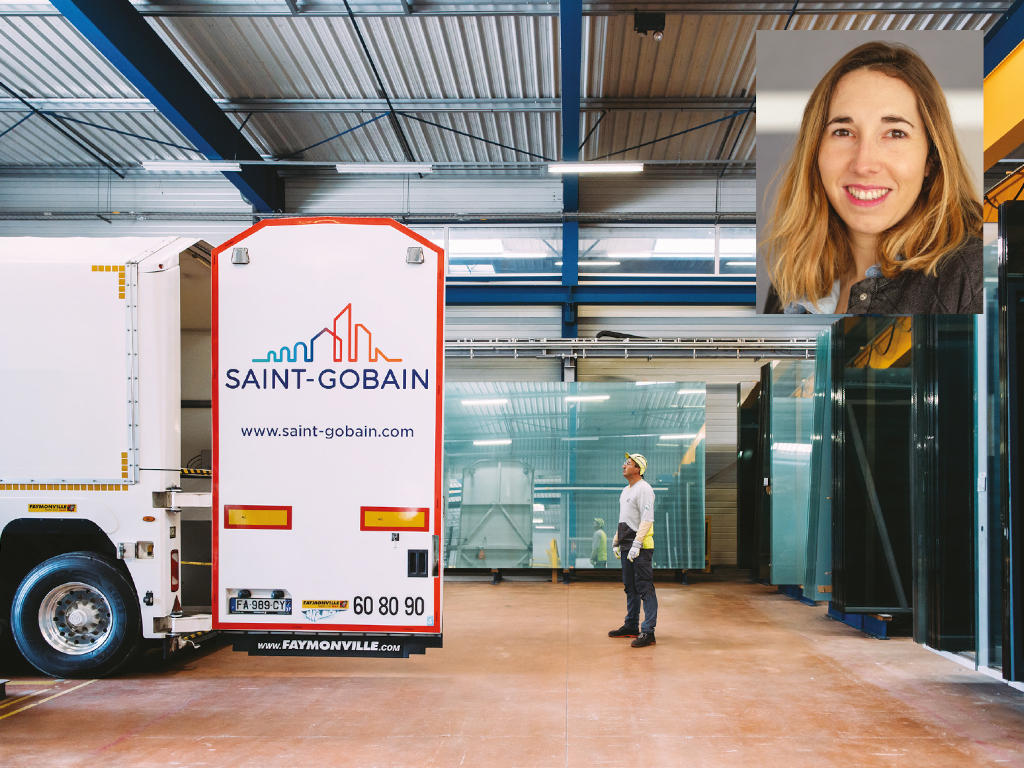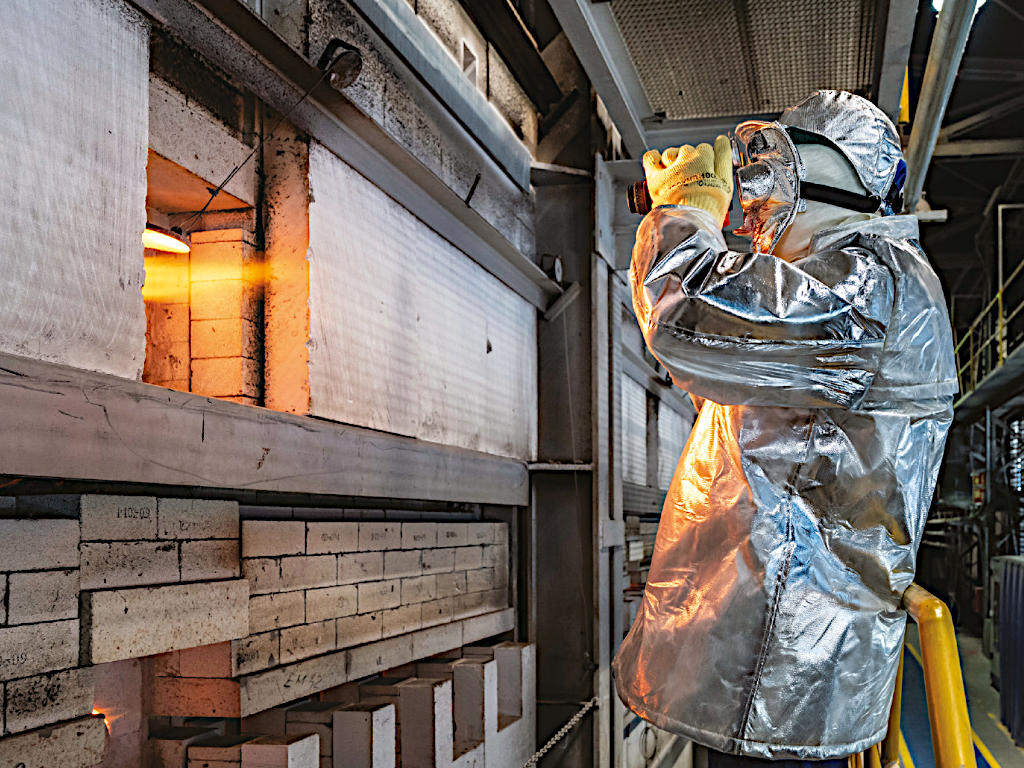Achieving a world-first
CO2 reduction is a key challenge for Saint-Gobain, which committed to reducing its emissions by 33% by 2030 and driving this figure to zero by 2050. To reach these goals, the company needs to manufacture glass products with a reduced CO2 content at a reasonable cost. According to Ms Arreguy, the main challenges are: “increasing circularity and our ability to recover end-of-life flat glass and reuse it in our flat glass furnaces once it is recycled; identifying existing carbon-free raw materials and setting up the appropriate supply chain; and probably the most complex: rethinking the design of our process to move away from fossil energies.
“One of the subjects on which I have worked the most in recent months is our industrial strategy relating to technological developments, partnerships, investments to decarbonise our production processes,” she continues. “This mission is very important to me as it meets both my professional objectives but also a more personal ambition for a more sustainable world.”
In May 2022 Saint-Gobain become the first-ever manufacturer to achieve zero-carbon production of flat glass – a feat that it demonstrated over four days at its Aniche plant in northern France, where it made a glass with the same optical characteristics as ‘traditional’ glass, produced from 100% cullet (end-of-life glass from renovation/demolition sites and from production offcuts) using decarbonised energies (biogas and carbon-free electricity).
“Some competitors used biofuel or reduced the emissions but never achieved zero-carbon on scope 1 and scope 2,” emphasises Ms Arreguy. She attributes Saint-Gobain’s success to the collaborative efforts of several cross-functional teams: R&D teams, experts from the industrial department and from the factory’s production team. “Strong expertise” ensured that furnace settings were optimally adjusted, while cullet collection from customers and renovation sites was achieved by setting up a specific supply chain and business model in each country, involving “many partnerships”, she recalls.
Low carbon – high electricity
At glasstec last year Saint-Gobain gave its sustainability strategy another boost with the launch of ORAÉ, a glass substrate with the world’s lowest carbon footprint. With a name derived from Greek mythology’s ‘Horae’: goddesses emblematic of seasons and the change of time – appropriate for the company’s latest game-changer, ORAÉ has an estimated carbon footprint of only 7kg CO2 eq./m2 (for a 4mm substrate), a reduction of approximately 40% compared to Saint-Gobain Glass European baseline clear glass. The company is integrating ORAÉ into its portfolio of solutions, starting with its COOL-LITE XTREME solar control glass – a combination that reduces both operational and embodied carbon.
“ORAÉ is a key milestone for Saint-Gobain,” confirms Ms Arreguy. “It was our ambition to be the first glass manufacturer to launch a low carbon product and we reached our goal. ORAÉ is the symbol of an industry that is looking for change. The next step is to make our customers aware of the benefits of reducing both operational and embodied carbon.”
In February 2023 Saint-Gobain announced a research and development partnership with AGC to build a pilot line for patterned glass at the latter’s facility in Barevka, Czech Republic that will have the highest electricity rate ever achieved in flat glass manufacturing: 50% electrified and 50% fired by a combination of oxygen and gas [see Glass Worldwide March/April 2023 news, p.6].
“Both companies believe that it is necessary to increase collaboration to tackle difficult challenges such as the production of flat glass using a process based mainly on electrical melting,” explains Ms Arreguy. “Saint-Gobain and AGC both have a very long history and expertise in glass manufacturing. In this project we put in common the best of our knowledge and innovation capacity. To reach new goals it is necessary to develop new methods and to collaborate.”
The new technology is expected to be implemented on AGC’s patterned glass line by the second half of 2024.
Supporting strategic investment
A strong commitment to innovation drives Saint-Gobain Glass’ focus on conceiving more sustainable buildings and processes as well as its development of top-performing products for the automotive and architectural markets. However, while the company’s long-term goal remains “to build a carbon-neutral Europe”, Ms Arreguy observes that, “this challenge does not have the same level of priority in all countries around the world. We therefore must be cautious and make sure our industry remains competitive at a local level."
“We continue to invest significantly in the processes that add value to our float glass,” she reports. “New coater lines, laminated glass lines and mirror lines are planned to be started in several regions of the world in the next years.”
This includes India, where Saint-Gobain is “just about” [at time of writing] to start a sixth float line in Bhiwadi, says Ms Arreguy. “Our flat glass business has been very successful in this region for decades and I am very excited about this new development,” she adds.
Saint-Gobain India commenced operations in 2000 and now manufactures and markets a wide variety of flat glass products and solutions from its plants in Sriperumbudur (Tamil Nadu), Jhagadia (Gujarat), and Bhiwadi (Rajasthan). In 2022, an INR 500-plus crore expansion at the company’s World Glass Complex at Sriperumbudur included a new float glass unit and an integrated windows line facility. “With five plants, we have over 50% of India’s float glass manufacturing capacity,” stated Saint-Gobain India – Glass Business’ Managing Director A. R. Unnikrishnan at the time.
Glass for Europe
Last year also saw Joana Arreguy elected Chairwoman of the Board of Directors at Glass for Europe – the trade association for Europe’s flat glass sector.
“It is a great honour for me to chair the Board of Directors of the Glass for Europe association,” she says. “2022 was the International Year of Glass which gave us several opportunities to make our voices heard on long-term topics such as circularity, carbon neutrality…"
“I probably bring new views,” she considers: “a willingness to continue pushing Europe to create the appropriate conditions for our industry to tackle the sustainability challenges and flourish in the coming years.”
The Board of Directors of Glass for Europe is composed of high-level representatives of the four leading EU-based float glass manufacturers, AGC Glass Europe, Guardian, NSG Group and Saint-Gobain Glass, and of one representative from flat glass and glazing national associations. Working closely with Vice Chairman Jean Ries, Director Government and Public Affairs at Guardian Europe, other Board members and the Glass for Europe team, Ms Arreguy intends to “nurture a collaborative approach and select our focus topics in consensual areas."
“Glass for Europe is our official voice towards European governing bodies and particularly the European Commission,” she notes. “Uniting our efforts to make the opinion of our industry heard is key to prepare the future.”
Keeping up to date with the trade association’s preferred journal can’t hurt either…
“Like many people in the glass industry I very much enjoy reading Glass Worldwide and appreciate the broad range of topics covered by this reference magazine and its in-depth articles,” concludes Ms Arreguy.
COOL-LITE and ORAÉ are registered trademarks of Saint-Gobain Glass.



